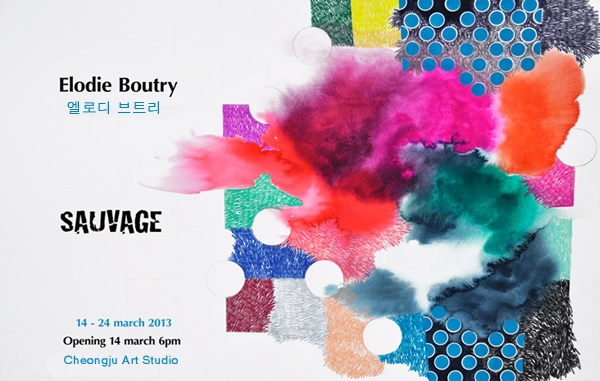지난 전시
 전시
지난 전시
전시
지난 전시
전시
안내
- 작가명
- 전시기간 2013-03-14 ~ 2013-03-24
- 전시장소 청주미술창작스튜디오
전시개요
Élodie Boutry, On pattern
Polka dots, stripes or checkers, painted in very bright colours: reds, yellows, blues, a lot of pinks. Since 2005, Elodie Boutry defines her language with these elements, building a syntax from repetitive patterns which she manages to work together, in combination or opposition. In the open air or within the space of an exhibition, her 3D paintings work on the question of illusion and of surface effects. They are situated on the repetitive side, smooth and ornamental, which includes incidents, crevices in the wall and visual projections. Perfectly contained in her means and ends, this work asks a question: how to create a strong visual language from a very limited vocabulary? In Élodie Boutry’s work, the answer is probably: by organising visual elements which provoke your gaze to swing.
In her outdoor paintings she thinks of the notion of rhythm and scansion on a very great scale. Applied with mathematical precision, her systems integrate perfectly within the accommodating space. The pattern’s regularity - built on the rhythm of serial music - is radically opposed by the irregularity of the bases. In the remains of demolished dwellings , warehouses, places of devastation, and even above doors - “dessus de porte” - she introduces a coloured shape where it does not have its place. The rhythm of her mural paintings is founded on alternations and ruptures using diagonals which reminds us of those made by painter Théo Van Doesburg: dynamic and non-orthodox, therefore placing itself in opposition to Mondrian. For her part, Elodie Boutry amply revitalizes her surfaces by the colours she chooses - always very bright - but also by creating a tension between the various modes of approach and different systems of construction. She throws the area off center with regard to the general structure of a piece, creating a separation between optical patterns almost traced with severity on the surface and a base full of outgrowths. The splits, the pillars that interject with the surface create an effect of breakage and movement, close to those which would outline a space where, on a piece of cloth, a seam would be left apparent.
Indoors, Élodie Boutry builds visual machines in 3D: big wooden painted cubes to which little expansions are incorporated. By adding these features, the artist recreates the irregularity of the surface on which she founds her in situ paintings. Thanks to those structures, which remind us of a sky-exploring device, or a time-machine in which she carefully handles peep-holes, we can look at the world “through” polka-dots or stripes - applied on the inside surfaces. From the inside out, she creates contrasts, cuts. Indeed in those visual objects the external surface is most of the time quite simple - white - sometimes covered in places by coloured sections. Whereas the inside multiplies crossed perspectives, movements, juxtaposed motives which resemble a tangle of shapes, close to weaving. Such a metaphor is of an importance in Boutry’s work. When she mentions her interest in Édouard Vuillard or Pierre Bonnard, she particularly insists on their using fabrics. In an interview, she says: “In 2003, I was deeply touched by an Édouard Vuillard exhibition: the wallpaper, the couch, the curtains. Women are dressed in dresses with similar patterns. I wondered why he remained at this stage without ever going towards abstraction .” In Boutry’s work, abstraction becomes a motive for the creation of new painting objects. In order to build her visual world, she looks at paintings but also at clothes shops and wallpapers; anything from which she can extract some reality to better shift it. For her, going to abstraction is to systematize, focusing the looker’s gaze on one single place, to only keep that piece of fabric or the wallpaper in a Vuillard painting, on the tablecloth in a Bonnard painting.
Through all these references, Élodie Boutry takes a very sensitive stand on the question of “ornamental”. Here, the word “ornamental” is meant in its literal and political meaning used by Matisse - and other 20th Century painters - as repetition of the same pattern, but also as excess and absence of organisation into a hierarchy between the work of art in itself and its frame. Leaving the actual painting behind, Boutry integrates and organises different environments: her position is really situated on a thread, where anything could topple over on the ornamental side if her paintings, lined with bright colours, did not create such subtle discontinuities towards its base. Besides, every time she creates geometrical shapes perfectly independent from bases from the real world, she creates an obvious gap towards it - the real world. At the same time, these works of art are perfectly practical. Their strong physical existence, their materiality itself sets them in space. The humour, also very present, add to their strength. These pieces become places where systems sometimes become unsettled, sometimes follow their logic - unruffled as obstacles stand in their way.
Élodie Boutry’s work is made of a vast visual game, a field to be experimented, a kinetic base but also an haptic object: its outgrowths are elements to be caught, up which one would like to climb. In 3D, these paintings are each time like an invitation to look up, to bend over: its colour goes through our gaze, clouded by mathematically biased games.
작가소개












